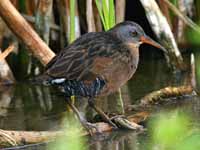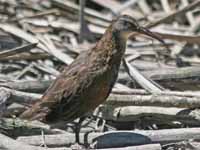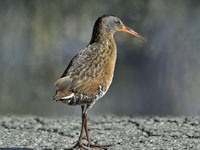THE WORLD BIRDS - An Online Bird Book
GRUIFORMES
Family Rallidae: Crakes, Rails (New World)
See also Crakes, Rails (Old World)
GRUIFORMES
Gruiformes means "crane-like", The order include 14 species of large cranes, about 145 species of smaller crakes and rails, as well as a variety of families comprising a small number of species.
Guiformes has the following families
Guiformes has the following families
Family Rallidae: Crakes, Rails (New World)
See also Crakes, Rails (Old World)
The crakes, and rails of the Railidae family generally occupy dense vegetation in damp environments near lakes, swamps, or rivers. They are omnivores. Most nest in dense vegetation. Most species walk and run vigorously on strong legs, and have long toes which are well adapted to soft, uneven surfaces. Some coots and gallinules have a "frontal shield", which is a fleshy rearward extension of the upper bill. The flight of those Rallidae able to fly, while not very powerful, can be sustained for long periods of time and many species undertake annual migrations.
Genus Amaurolimnas - 1 species
Crake,_Uniform Amaurolimnas concolor Found: Mexico to South America
The Uniform Crake has dull rufous plumage; dull yellowish-green bill; pink legs.
Image by: 1) Cornell_Univ's_Neotropical_Birds_Online - Daniel_Lopez-Velasco 2) Hector_Bottai - Brazil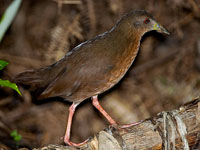
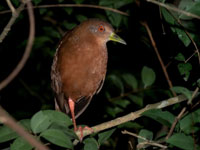
Genus Anurolimnas Found in: South America
These species all have at least some rufous on their heads and underparts.
Crake,_Black-banded Anurolimnas fasciatus Found: Brazil, Colombia, Ecuador, Peru
The Black-banded Crake has brown back, wings; rufoul head, underparts; broad black bars on belly.
Image by: 1) Joseph_Smit 2) Cornell_Univ's_Neotropical_Birds_Online - Luke_Seitz in Ecuador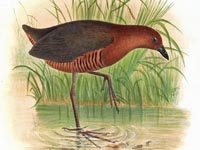
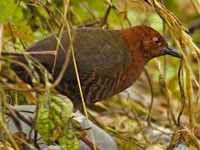
Crake,_Chestnut-headed Anurolimnas castaneiceps also Laterallus castaneiceps Found: Bolivia, Brazil, Colombia, Ecuador, Peru
The Chestnut-headed Crake has dark brown back, wings, belly; rufous head, breast.
Image by: 1) Joseph_Smit 2) Cornell_Univ's_Neotropical_Birds_Online - Tomaz_Melo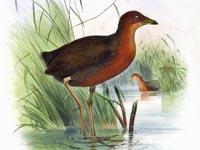
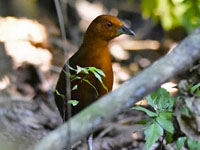
Crake,_Russet-crowned Anurolimnas viridis also Laterallus viridis Found: South America
The Russet-crowned Crake has brown back, wings, face; rufous crown, underparts.
Image by: 1, 2) Alex_Popovkin - Brazil 3, 4) Luiz Carlos Rocha - Brazil
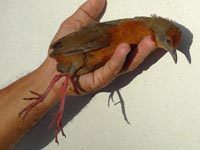
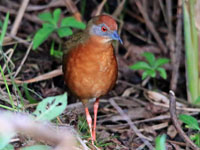
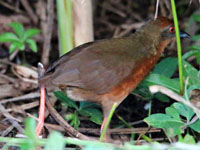
Genus Aramides
The Wood-Rails.
Rail,_Brown_Wood- Aramides wolfi Found: Columbia, Ecuador
Image by: 1) 1) Nick_Athanas 2) Cornell_Univ's_Neotropical_Birds_Online - Eduardo_Carrion_Letort in Ecuador

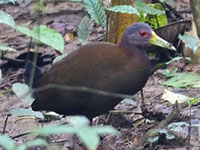
Rail,_Giant Wood- Aramides ypecaha Found: South America
Image by: 1, 2) Dick Daniels - World of Birds, South Africa 3) Sandy Cole - World of Birds 4) Cludio Timm - Rio Grande do Sul, Brazil 5) Claudio Timm - Brazil 6) Cristiano Crolle - Esteros del Iberà, Argentina

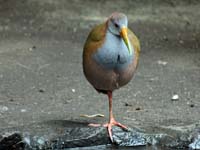
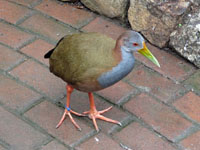
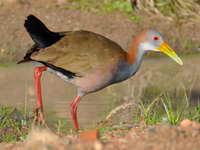
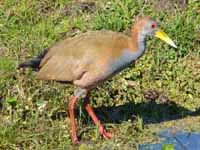
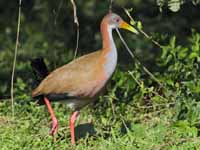
Rail,_Gray-cowled_Wood- also Gray-necked Wood-Rail Aramides cajaneus Found: Costa Rica, Panama, South America
T
he Russet-naped Wood-Rail was formerly conspecific with the Gray-cowled Wood-Rail to form the Gray-necked Wood-Rail
Image by: 1) Casliber2) Alejandro 2) Tamayo - Columbia 3) Bernard_Dupont - Brazil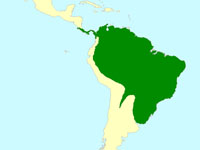
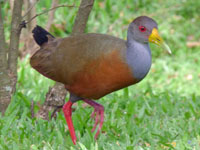

Rail,_Little_Wood- Aramides mangle Found: Brazil
Image by: 1) Dario_Sanches 2) Cornell_Univ's_Neotropical_Birds_Online - Ciro_Albano

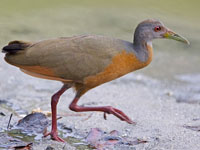
Rail,_Red-winged_Wood- Aramides calopterus Found: Brazil, Ecuador, Peru
Image by: 1) pinterest

Rail,_Rufous-necked_Wood- Aramides axillaris Found: Mexico, Central America, northern South America
Image by: 1, 2) Jerry_Oldenettel - New Mexico 3) Jorge_Montejo - Mexico
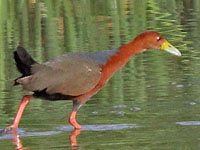
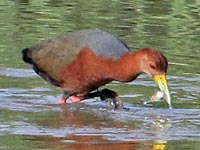
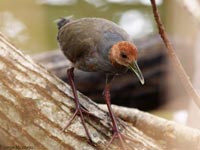
Rail,_Russet-naped_Wood- Aramides albiventris Found: Mexico to Costa Rica
The Russet-naped Wood-Rail has olive-green to dark brown upperparts; medium gray head neck blending to brown patch at back of head; red eyes; rufous breast, flanks; black belly, rump, tail.
The Russet-naped Wood-Rail was formerly conspecific with the Gray-cowled Wood-Rail to form the Gray-necked Wood-Rail
Image by: 1, 2) Hans Hillewaert - Costa Rica 3) Dan_Irizarry - NicaraguaThe Russet-naped Wood-Rail was formerly conspecific with the Gray-cowled Wood-Rail to form the Gray-necked Wood-Rail
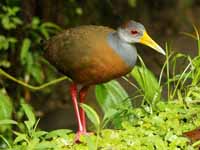
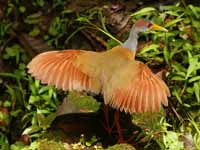
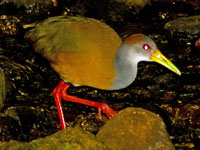
Rail,_Slaty-breasted Wood- Aramides saracura Found: South America
Image by: 1) Adrian198cm- Curitiba, Brazil 2, 3) Dario Sanches - Brazil
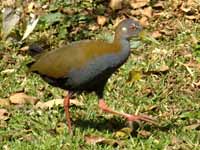
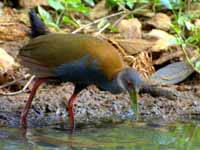

Genus Coturnicops
See also Coturnicops Old World.
Rail,_Speckled Coturnicops notatus Found: South America
Image by: 1) David_Juszczuk - Argentina Cornell_Univ's_Neotropical_Birds_Online - Alec_Earnshaw
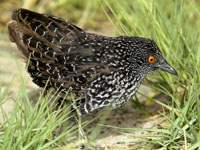
Rail,_Yellow Coturnicops noveboracensis Found: North America
They Yellow Rail has brown upperparts with black streaks; yellowish-brown breast; light belly with barred flanks; broad yellow supercilium; greenish-yellow legs. Male's bill turns yellow during breeding season.
Similar to: Sora. Yellow Rail has more yellow than the Sora does.
Image by: 1) Lisapham 2) Dominic Sherony - MichiganSimilar to: Sora. Yellow Rail has more yellow than the Sora does.
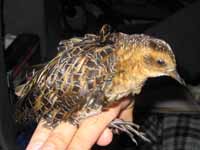
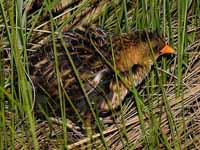
Genus Cyanolimnas - 1 species
Rail,_Zapata Cyanolimnas cerverai Found: Cuba
The Zapata Rail has brown upperparts; grayish-blue underparts; red-based yellow bill; white undertail; red eyes, legs.
Image by:
1) Allan_Brooks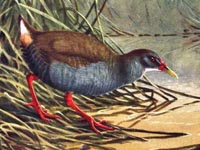
Genus Hapalocrex
Crake,_Yellow-breasted Hapalocrex flaviventer also Porzana flaviventer Found: Mexico, Central and South America, Csribbean
The Yellow-breasted Crake does not seem to be part of Porzana proper, but , its precise relationships are still insufficiently resolved.
Image by: 1) Hector Bottai 2) Claudio_D_Timm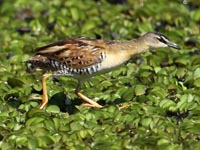
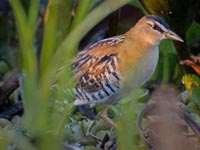
Genus Laterallus
These small, relatively short-billed terrestrial rails are found among dense vegetation near water.
Crake,_Gray-breasted Laterallus exilis Found: Central and South America
Image by: 1)Nick_Athanas 2. 3) Cornell_Univ's_Neotropical_Birds_Online - Henry_Sandi_Amador, Joao_Quental

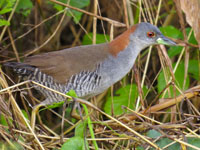
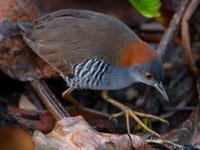
Crake,_Red-and-white Laterallus leucopyrrhus Found: South America
The Red-and-whiite Crake is found in Argentina, Brazil, Paraguay, and Uruguay.
Image by: 1) Francesco_Veronesi - Brazil 2) Tony_Morris 3) Claudio Timm 4) Nick_Athanas 5) William_Kreijkes
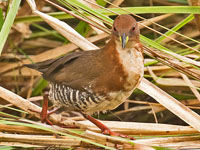

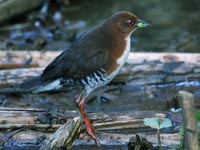

Crake, Ruddy Laterallus ruber Found: Mexico to Costa Rica
The Ruddy Crake has mostly bright chestnut plumage with a paler chin and belly; blackish crown; dark gray ear coverts; red iris, legs; black bill; olive-green feet.
Image by: 1, 2) Cornell_Univ's_Neotropical_Birds_Online - Jorge_Dange, Carlos_Echeverrial1) Female
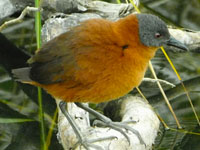

Crake,_Rufous-faced Laterallus xenopterus Found: Bolivia, Brazil, Paraguay
Image by: 1. 2) Cornell_Univ's_Neotropical_Birds_Online - Cal Martins, Jon_Hornbuckle 3) Hector_Bottai - Brazil

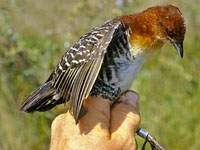
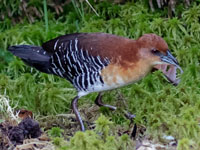
Crake,_Rufous-sided Laterallus melanophaius Found: South America
Image by: 1, 2) Claudio Timm - Brazil 3) Dario_Sanches 4) Nick_Athanas
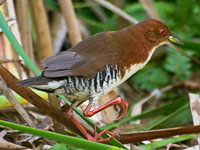
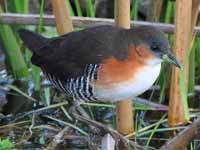
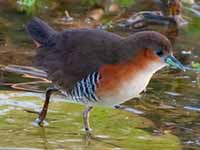
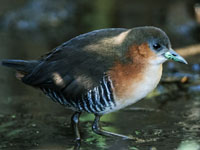
Crake,_Rusty-flanked Laterallus levraudi Found: Venezuela
The Rusty-flanked Crake is the only crake with red flanks in its range.
Image by: 1) Cornell_Univ's_Neotropical_Birds_Online - Jhonathan_Miranda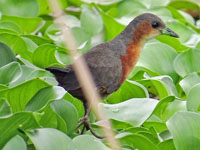
Crake,_White-throated Laterallus albigularis Found: Central America, Columbia, Ecuador
Image by: 1) Cornell_Univ's_Neotropical_Birds_Online - Cory_Gregory in Costa Rica 2) Dominic_Sherony 3) Andy_Jones - Costa Rica
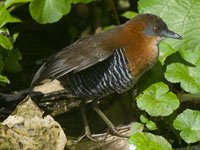
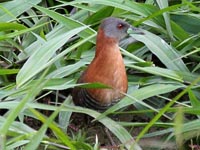
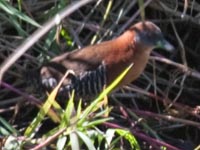
Rail,_Black Laterallus jamaicensis Found: The Americas
Similar to: Sora. Black Rail is darker than Sora. In particular, Sora has a yellow bill and Black Rail has a black bill.
Image by: 1) Danika Tsao, USGS 2) Thomas Gilbert Pearson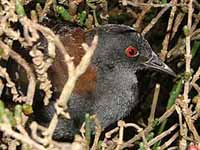
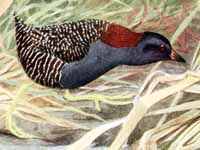
Rail,_Galapagos also Galapagos Crake Laterallus spilonota Found: Galapagos
The Galapagos Rail has dark gray head, underparts.
Image by: 1) John Gould 2) Francisco Laso 3) Andy_Kraemer
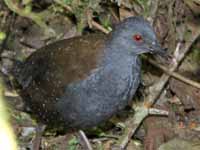
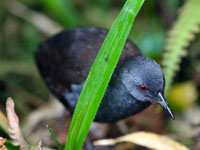
Genus Micropygia - 1 species
Crake,_Ocellated Micropygia schomburgkii Found: South America
Image by: 1, 2) Cornell_Univ's_Neotropical_Birds_Online - Jonatas_Roch, John_Mittermeier in Brazil, Suriname


Genus Mustelirallus
Crake, Ash-throated Mustelirallus albicollis Found: South America
The Ash-throated Crake has olive-brown streaks on darh back; black tail; light gray underparts; black-and-white barred lower flanks; greenish-yellow bill; greenish legs.
Image by: 1) Elis Simpson 2) Joao Menezes - Brazil 3) Cornell_Univ's_Neotropical_Birds_Online - Mark_Dennis in Brazil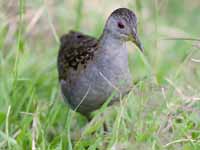


Crake,_Columbian Mustelirallus colombiana Found; Columbia, Ecuador, Panama
Image by: 1) Bonner zoologische Monographien

Crake,_Paint-billed Mustelirallus erythrops Found: Costa, Panama, South America
Image by: 1) Joseph_Smit 2) Cornell_Univ's_Neotropical_Birds_Online - Anselmo_d'Affonseca
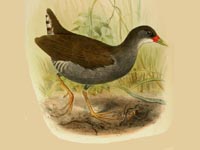
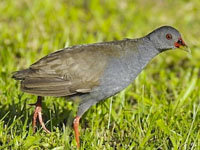
Genus Pardirallus
These rails have a long greenish bill and reddish legs.
Rail,_Blackish Pardirallus nigricans Found: South America
The Blackish Rail has brown upperparts; gray underparts; black tail; red legs; yellow-green bill with yellow base.
Image by: 1) Nick_Athanas 2) Ben Travener - Brazil 3) Columbia Travel - Columbia 4) Arley_Vargas1) Juvenile - rear; adult - front.

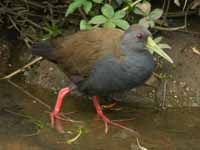
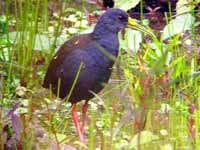
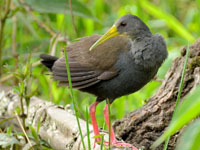
Rail,_Plumbeous Pardirallus sanguinolentus Found: South America
The Plumbeous Rail has brown upperparts; gray underparts; dark tail; red legs; yellow-green bill; blue base of upper mandible, red base of lower mandible..
Image by: 1, 2, 3) Cláudio Timm - Rio Grande do Sul, Brazil 4) Nick_Athanas - Argentina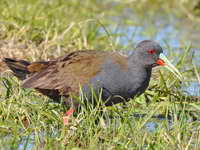
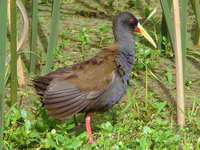
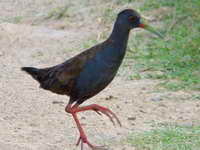
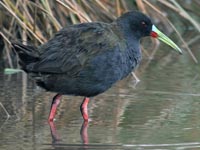
Rail,_Spotted Pardirallus maculatus Found: Mexico, Central America, South America
The Spotted Rail has black plumage with white spots; red legs; yellow-green bill; red base of lower mandible..
Image by: 1) Gustavo_Fernando_Duran - Argentina 2) Nick_Athanas - Peru 3) Rick Simpson 4) Hector_Bottai - Brazil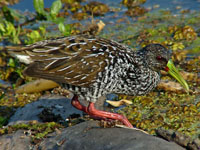
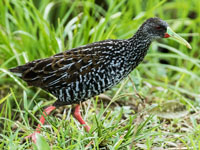
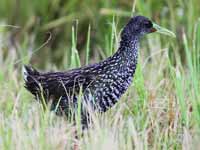
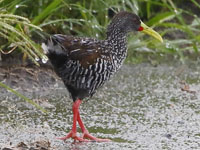
Genus Porzana
See also Porzana Old World.
Crake,_Dot-winged Porzana spiloptera Found: Argentina, Brazil, Uruguay
The Dot-winged Crake has brown upperparts with some black striping; white barrring on wings; dark gray underparts with white barring on belly.
Image by: 1, 2, 3) Claudio_D_Timm
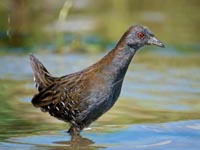
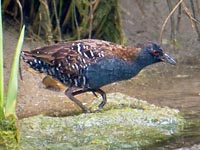
Sora Porzana carolina Found: The Americas
The Sora has mottled dark brown upperparts; blue-gray face, underparts; black and white barring on flanks; short thick yellow bill; black marking at base of bill; black on throat while breeding.
Similar to: Black Rail. Black Rail is darker than Sora. In particular, Sora has a yellow bill and Black Rail has a black bill.
Similar to: Yellow Rail. Yellow Rail has more yellow than Sora.
Image by: 1) Charlie Westerinen - Malheur National Widelife Reserve in Oregon 2) Kelly Colgan Azar 3) Elaine R. Wilson - the Birding Center, Port Aransas,
Texas 4, 5) Mike Baird - California Similar to: Black Rail. Black Rail is darker than Sora. In particular, Sora has a yellow bill and Black Rail has a black bill.
Similar to: Yellow Rail. Yellow Rail has more yellow than Sora.
1) Juvenile 2, 3) Nonbreeding 4, 5) Breeding
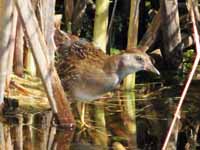
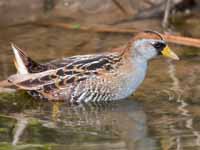
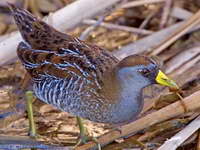
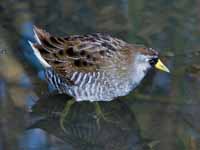

Genus Rallus
These are slim, long-billed rails with slender legs. Their laterally flattened bodies are an adaptation to life in wet reedbeds and marshes, enabling them to slip easily through the dense semi-aquatic vegetation. Typically these birds have streaked brown upperparts, blue-grey on the face or breast, and barred flanks.
See also Rallus Old World.
Rail,_Austral Rallus antarcticus Found: southern Argentina and Chile
Image by: 1) Joseph_Smit 2) Cornell_Univ's_Neotropical_Birds_Online - Sebastian_Saiter_Villagran
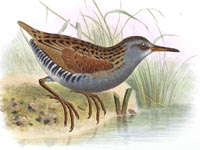
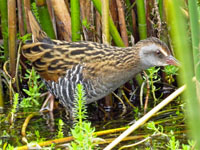
Rail,_Aztec also Mexican Rail Rallus tenuirostris Found: Mexico
The Aztec Rail used to be a subspecies of the King Rail
Image by: 1) Bryant_Olsen 2, 3) Cornell_Univ's_Neotropical_Birds_Online - Pete_Morris, Jose_Martinez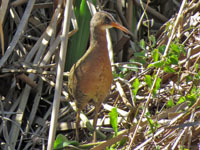

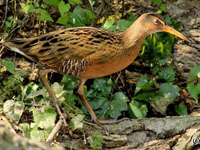
Rail,_Bogota Rallus semiplumbeus Found: Columbia
Image by: 1) Nick_Athanas 2) Neil_Martinez
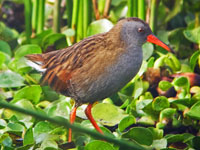
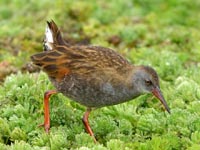
Rail,_Clapper Rallus crepitans Found: North America
The Mangrove Rail and Ridgway's Rail were formerly considered conspecific with the Clapper Rail.
Similar to: King Rail. Clapper Rail is predominantly an East Coast or Gulf Coast species. In addition to these locations, the King Rail can also be found hundreds of miles inland. The white bars on adult King Rails are more pronounced than on Clapper Rails.
Similar to: Virginia Rail. Clapper Rail are rufous; Virginia Rail are brown.
Image by:
1) Len Blumin 2) Riverbanks Outdoor Store - Florida 3) Alan D. Wilson - South Padre Island, Texas 4) Dick Daniels - North CarolinaSimilar to: King Rail. Clapper Rail is predominantly an East Coast or Gulf Coast species. In addition to these locations, the King Rail can also be found hundreds of miles inland. The white bars on adult King Rails are more pronounced than on Clapper Rails.
Similar to: Virginia Rail. Clapper Rail are rufous; Virginia Rail are brown.
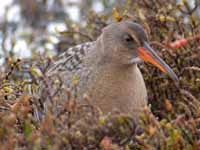

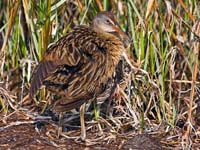
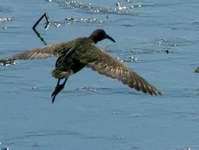
Rail,_King Rallus elegans Found: North America
Similar to: Clapper Rail. Clapper Rail is predominantly an East Coast or Gulf Coast species. In addition to these locations, the King Rail can also be found hundreds of miles inland. The white bars on adult King Rails are more pronounced than on Clapper Rails.
Similar to: Virginia Rail. King Rail are rufous; Virginia Rail are brown.
The Aztec Rail used to be a subspecies of the King Rail
Image by: 1) Jim Rathert - Missouri 1, 3, 4) Carol Foil - LouisianaSimilar to: Virginia Rail. King Rail are rufous; Virginia Rail are brown.
The Aztec Rail used to be a subspecies of the King Rail
1) Chick 2) Juvenile 3, 4) Male
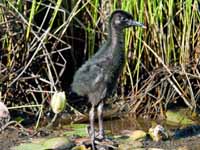
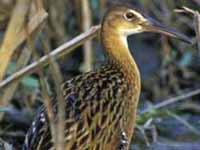
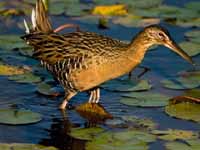
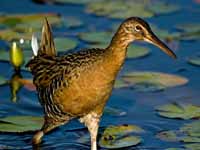
Rail,_Mangrove Rallus longirostris Found: South America
The Mangrove Rail was formerly considered conspecific with the Clapper Rail.
Image by: 1) Claudio_D_Timm - Brazil 2) Cornell_Univ's_Neotropical_Birds_Online - Adriana_Rodríguez in Venezuela1) Rallus longirostris crassirostris
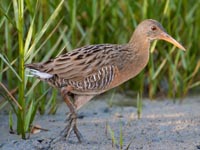
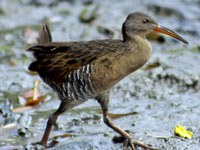
Rail,_Plain-flanked Rallus wetmorei Found: Venezuela
Image by: 1, 2) Cornell_Univ's_Neotropical_Birds_Online - David J. Southall , Andrea_Fonseca
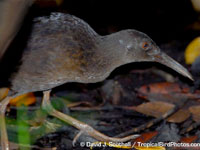

Rail,_Ridgway's Rallus obsoletus Found: San Francisco Bay, California to southern Baja California
The Rigway's Rail was formerly a subspecies of the Clapper Rail. It has streaked grayish-brown upperparts; chestnut-orange beast; long down-curved bill.
Image by: 1) Aaron_Maizlish - Oakland, California 2) Len_Blumin - California 3) Becky_Matsubara1, 2) Juvenile

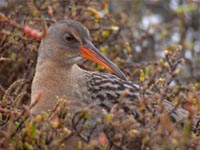

Rail,_Virginia Rallus limicola Found: The Americas
The Virginia has mainly brown plumage; dark on back and crown; oramge-brown legs.
Similar to: Clapper Rail, King Rail. Clapper Rail and King Rail are rufous; Virginia Rail is brown.
Image by: 1) Mike Baird - California 2) Blake Matheson - California 3) Allan Hack 4) Christian Fritschi - QuebecSimilar to: Clapper Rail, King Rail. Clapper Rail and King Rail are rufous; Virginia Rail is brown.

